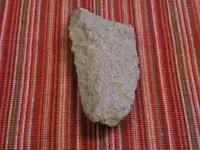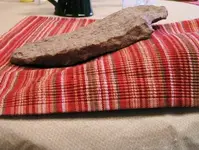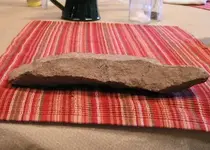Reanm8er
Bronze Member
- Joined
- Aug 17, 2018
- Messages
- 2,283
- Reaction score
- 3,556
- Golden Thread
- 0
- Location
- Shenandoah Valley Va
- Detector(s) used
- WW2 Mine Detector, 2 Garrets and an Underwater Fisher (Older Machines)
- Primary Interest:
- All Treasure Hunting
This is not a new find but I thought it might be pertinent to the current circumstances. The photos show an stone adz that I found on a hunting ground along the Shenandoah river in September 1996. The river crested at 29' as a result of rainfall from hurricane Fran. I know that many of these adz finds have been classified as rocks but I believe this one to be genuine.






Archaeologists don't believe the natives made or used dugout canoes, mostly because they've never found one. I've seen the Shenandoah propel a full size house trailer
along with the speed of a torpedo. A dugout canoe wouldn't have stood a chance! I found the artifact about a hundred yards back from the currant bank in area that becomes the bank in a hundred year stage flood. The area could have at one time been the main bank of the river. It has plainly been worked and features something that I've never seen on a native artifact. Looking at the front view of this tool notice the angles tapering down from the edges. They're pretty much the same angle on both sides. This person not only knew how to create an edge, he also utilized a relief angle below the edge. This is something that is most important when plunge cutting in wood because without it the blade would stick. The relief angle allows the chips to clear themselves from the cut and makes the tool more efficient. This is a built in feature of modern metal removal tools, and even wood saw blades and routers. Most edges are relieved by about 30 degrees and so is this.
Thanks for looking folks!






Archaeologists don't believe the natives made or used dugout canoes, mostly because they've never found one. I've seen the Shenandoah propel a full size house trailer
along with the speed of a torpedo. A dugout canoe wouldn't have stood a chance! I found the artifact about a hundred yards back from the currant bank in area that becomes the bank in a hundred year stage flood. The area could have at one time been the main bank of the river. It has plainly been worked and features something that I've never seen on a native artifact. Looking at the front view of this tool notice the angles tapering down from the edges. They're pretty much the same angle on both sides. This person not only knew how to create an edge, he also utilized a relief angle below the edge. This is something that is most important when plunge cutting in wood because without it the blade would stick. The relief angle allows the chips to clear themselves from the cut and makes the tool more efficient. This is a built in feature of modern metal removal tools, and even wood saw blades and routers. Most edges are relieved by about 30 degrees and so is this.
Thanks for looking folks!
Amazon Forum Fav 👍
Last edited:
Upvote
5



